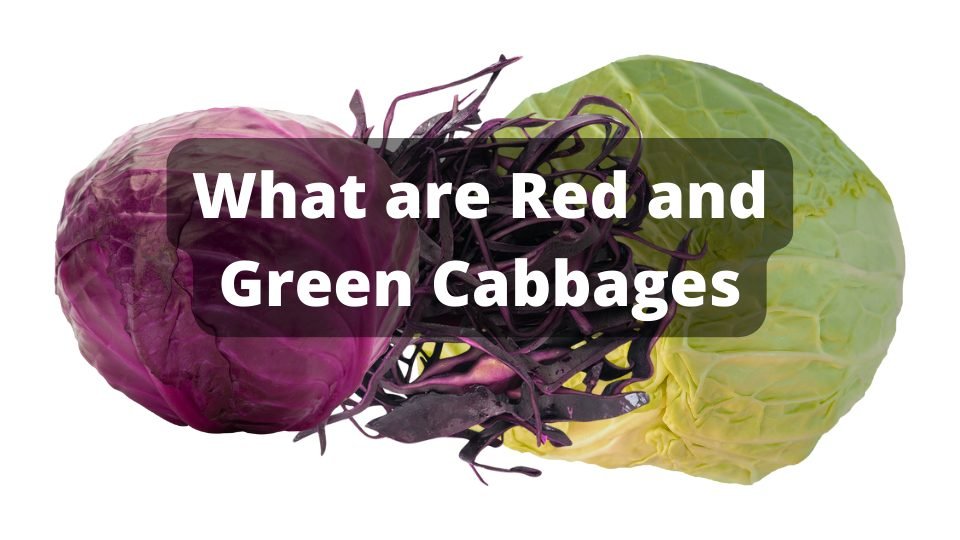Red Cabbage vs Green Cabbage
Everybody knows that green cabbage and red cabbage are related to each other, but you may be surprised to find out just how closely they’re related! Both types of cabbage are cruciferous vegetables, meaning they share many similar nutrients, such as vitamin C, vitamin K, and beta-carotene. But although both cabbages have similar nutrients, there are also some subtle yet important differences between the two types of cabbage. Read on to find out whether red or green cabbage is the better choice for your diet!
Table of Contents
ToggleWhat are Red and Green Cabbages?

Red and green cabbages are both members of Brassica oleracea, which means they are essentially cousins; however, that’s where any similarities end. Red and green cabbages have slightly different characteristics and use in recipes as well as cooking preparation methods that can produce vastly different results when it comes to appearance, taste, flavor, and even calories and nutrition! So what are red and green cabbages? And how can you use them in your meals? Read on for an enlightening comparison of red cabbage vs green cabbage—including side-by-side comparisons of nutritional value!
They Look Different

Many people confuse red cabbage and green cabbage because they appear to be similar vegetables. They do look different, but there are many similarities between them as well, including their taste and health benefits. Red cabbage may seem more appealing because of its striking red color, but don’t be deceived by its vibrant exterior; it’s still just a green cabbage that has been exposed to harsh sunlight! The deep hue of red cabbage comes from anthocyanin pigments that provide antioxidant properties, which help protect against free radical damage and cancer-causing cell mutation. While both types of cabbage contain these antioxidants, red cabbage contains much higher levels than green cabbage. In fact, when compared gram for gram, red cabbage contains over five times more antioxidants than its lighter counterpart. Anthocyanins also give red cabbage its anti-inflammatory effects—which can help fight asthma symptoms—and promote healthy blood flow in your brain and heart. This is due to their ability to lower blood pressure and reduce cholesterol levels in your body. Both cabbages contain high amounts of vitamin K—an essential nutrient for bone health—but red cabbage contains nearly three times as much vitamin K as green cabbage does.
They Taste Different
It’s no secret that red cabbage and green cabbage look different. But there’s more to their appearance than meets the eye—there are actually differences in taste, too! While both kinds of cabbage have a natural taste, red cabbage has a stronger flavor and is sweeter than green. In fact, red cabbage is sometimes eaten raw; when it’s added to salad or coleslaw, it tends to act as an accent flavor rather than the main ingredient. On its own or with other vegetables like carrots and apples, red cabbage can also be enjoyed raw as crudités. Or add it to your favorite dishes for an extra boost of sweet-and-sour flavor!
Let’s Get Technical: (Red Cabbage vs Green Cabbage)
Green cabbage is simply a whole head of red cabbage that has been treated with lactic acid to turn it green—but don’t let that scare you away. Just because it isn’t natural doesn’t mean it isn’t good for you; in fact, green cabbage is slightly higher in vitamins than its ruddy cousin. Both cabbages contain ample amounts of vitamin K, which helps to fight plaque and maintain bone health, as well as plenty of vitamin C to boost your immune system and fend off illness. However, green cabbage also contains more calcium than red cabbage, helping to build strong bones and teeth. So what’s better? It depends on what you plan on using it for. If you want an easy way to get more greens into your diet without having to deal with large leaves or thick stalks, go with green cabbage. However, if you want a versatile food that can be used in almost any recipe (think coleslaw or sauerkraut), stick with red cabbage. Either way, both cabbages are delicious when cooked properly!
Why Are They So Different?

Both red and green cabbage are cruciferous vegetables that belong to the same family, Brassica oleracea. They’re very similar in a lot of ways, but there are key differences that affect how you cook them, which ones you should use for certain recipes, and their health benefits (or potential drawbacks). The real differences between red and green cabbage depend on many factors—including where they were grown and what season it is—but they boil down to two main categories: color and flavor/texture. Here’s what you need to know about red vs. green cabbage!
Since these cabbages have distinct flavors and textures, chefs often use them in different dishes or even as substitutes for each other if they’re not available. For example, some Irish cooks will sub out green cabbage with red when making colcannon, while Vietnamese cooks often replace Chinese napa cabbage with red versions in stir-fries and salads. It all comes down to personal preference! But if you want a more nutrient-dense dish or have guests who aren’t into spicy food, using white cabbage instead might be your best bet. Be sure to let us know which type of cabbage you prefer in the comments below!
This was written by @Kirsten from @CleverWords94
How Do I Choose Between Them?

Which is better? Which should I use more often? These are questions I’m asked all of the time, and for good reason. There’s a lot of confusion when it comes to buying cabbage—and it stems from how similar green and red cabbage are on paper (and in our kitchens). That said, I think you need to consider three factors: flavor, nutrition, and appearance before making your decision. So let’s break it down…shall we? [1] Red or Green?: You might be surprised to learn that red cabbage actually has about twice as much vitamin A as green cabbage does. That said, it doesn’t have nearly as much vitamin C or fiber as its lighter counterpart. Because of that, if you like using vegetables for their health benefits and want something high in vitamin A but low in fiber, then go with red! If not, stick with green!






